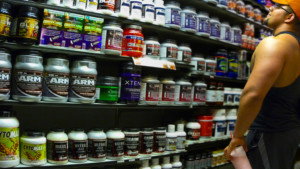Learn Why Beta-Alanine Boosts HIIT

High-intensity interval training (HIIT) covers a wide range of cardio exercise regimes and is a popular way to work-out due to its multitude of benefits. HIIT can increase resting metabolism, elevate fat burning, and enhance anaerobic and aerobic fitness.
More people are turning to HIIT because they are able to achieve better fitness results faster. However, to take advantage of the maximum benefits of HIIT, more athletes are supplementing with beta-alanine, and with good reason.
Beta-alanine is a non-essential amino acid and highly concentrated inside the muscle tissue.
The body is able to produce its own beta-alanine. However, a diet rich in animal proteins or supplements effectively increases these levels further. Anyone wanting to get a fitness edge and accelerate muscle building through HIIT can significantly benefit from beta-alanine supplementation.
The Science Behind Beta-Alanine
During exercise beta-alanine buffers muscle pH to reduce fatigue. This amino acid is the precursor to carnosine through rate limitation. The more beta-alanine available, the more carnosine the body’s muscle cells are able to manufacture.
Carnosine is important when working-out because it controls lactic acid levels. HIIT is based on high-frequency muscular contractions, causing the body to accumulate high levels of hydrogen ions. This process causes the muscles to become more acidic as pH levels decrease.
Low pH levels adversely affect muscle performance and lead to fatigue1. Carnosine buffers muscle pH by absorbing the excess hydrogen ions that are released during HIIT. This helps to reduce the stress on the muscles. As well as boosting intra-muscular pH, carnosine provides antioxidant benefits. It stops protein glycation and can improve exercise output by increasing excitation-contraction coupling2.
Researchers have found that athletes with naturally high carnosine levels in their muscles are able to exercise more effectively and this can lead to better muscular gain, power and strength. Clinical studies assessing muscle biopsies have found that beta-alanine can elevate carnosine levels from 42-80% depending on the dosing levels and duration3.
Carnosine Vs. Beta-Alanine Supplementation
Although it is carnosine that helps to improve muscle performance and recovery, this doesn’t mean that supplementation with this amino acid is effective. Supplementing with beta-alanine is more effective compared with carnosine. This is because the body will eliminate or breakdown carnosine into histidine or beta-alanine when it is ingested. An insufficient source of beta-alanine, it is more efficient to elevate carnosine levels through supplementation with beta-alanine.
What The Research Shows
Many studies have confirmed that HIIT can be enhanced by beta-alanine supplementation through improving anaerobic performance, power output, lean muscle mass, and muscular strength4, 5, 6. Side effects of beta-alanine supplementation seem to be minimal, with a general consensus that this is a safe nutritional supplement7.
Taking Beta-Alanine with Creatine
 Many amino acids work in synergy, with the positive effects of each compound enhanced when consumed together. This is apparent when combining creatine and beta-alanine. Ingested together, these compounds seem to delay the onset of muscular fatigue better than taking creatine or beta-alanine independently8.
Many amino acids work in synergy, with the positive effects of each compound enhanced when consumed together. This is apparent when combining creatine and beta-alanine. Ingested together, these compounds seem to delay the onset of muscular fatigue better than taking creatine or beta-alanine independently8.
For athletes participating in HIIT the combination of beta-alanine and creatine can assist to increase work capacity and lengthen the time to fatigue. Consequently, many pre-workout supplement products also include a blend of beta-alanine and creatine.
A study published in 2006 investigated the effects beta-alanine (3.2 g/day) plus creatine (10.5 g/day) on power, strength, endocrine function, and body composition in American football players9. The participants took part in a 10 week resistance training program incorporating the new supplement regime. Hoffman and colleagues found that beta-alanine together with creatine was effective for enhancing strength performance and increasing lean muscle mass.
Therefore, creatine together with Beta-Alanine Boosts HIIT.
Natural Beta-Alanine Sources
Very little free-form beta-alanine is available from food sources. The body produces it own Beta-Alanine naturally by breaking down dipeptides such as balenine, anserine and carnosine. These compounds come from proteins such as pork, beef, tuna and venison. Muscle carnosine levels are generally much lower in people following vegetarian diets.
To boost carnosine concentrations, athletes participating in HIIT generally take supplements. They often combine them with creatine, BCAAs and other amino acids known for improving power, strength and endurance.
Dosage – How Much Beta-Alanine?
The optimal amount of beta-alanine supplementation for HIIT is debatable and the literature recommends differing amounts. The standard daily dose is 2-5g. However, many athletes take much larger doses.
It’s important to note that taking large doses of this amino acid can cause pricking, tingling, or numbness sensations on the skin, known as parenthesis. However, with more frequent use, this sensation often reduces in severity10. To avoid parenthesis, some athletes prefer using time-release capsules.
Should You Take Beta-Alanine For HIIT?
Decisions about fitness must always consider what is healthy for the body. They types of training regimes, sleeping patterns, diet and supplements are all important factors. It’s important to know that the foods you are consuming are safe and will support your training schedule without causing adverse side effects.
Beta-alanine supplementation is a relatively new area of research in respect to HIIT. However, the clinical data to date has overall been positive. This amino acid is beneficial for people participating in high-intensity exercise and training. As with any supplement, it is always important to seek professional advice and gain the approval of your doctor to ensure that there are no underlying risks.
References
- “Bangsbo, J. et. al. (1996). Effect of muscle acidity on muscle metabolism and fatigue during intense exercise in man. Journal of Physiology. Volume 495, Issue 2, (pp. 587-596).” ↩
- “Guiotto, A. et. al. (2005). Carnosine and Carnosine-Related Antioxidants: A Review. Current Medical Chemistry, Volume 12, Issue 20, (pp. 2293-2315).” ↩
- “Harris, R., et al. (1998). Carnosine & Taurine contents in individual fibers in human vastus lateralis muscles. Journal of Sports Science. Volume 16, Issue 7, (pp. 639-643).” ↩
- “Hoffman, J. et al. Wise (2008). Beta-Alanine and the Hormonal Response to Exercise. International Journal of Sports Medicine. Volume 29, Issue 12, (pp. 952-8). ↩
- “Artioli G, et al. (2010). Role of beta-alanine supplementation on muscle carnosine and exercise performance. Medicine and Science in Sports Exercise. Volume 4, Issue 6, (pp. 1162-73).” ↩
- “Smith A. et al. (2009). Effects of beta-alanine supplementation and high-intensity interval training on endurance performance and body composition in men; a double-blind trial. Journal of the International Society of Sports Nutrition. Volume 6, Issue 5, doi: 10.1186/1550-2783-6-5. ↩
- “Quesnele, J. et al. (2014). The effects of beta-alanine supplementation on performance: A systematic review of the literature. International Journal of Sport Nutrition and Exercise Metabolism. Volume 24, Issue 1, (pp 14-27).” ↩
- “Zoeller, R. et al. (2007). Effects of 28 days of beta-alanine and creatine monohydrate supplementation on aerobic power, ventilatory and lactate thresholds, and time to exhaustion. Amino Acids. Volume 33, Issue 3, (pp. 505-510).” ↩
- “Hoffman, J et al. (2006). Effect of Creatine and beta-Alanine Supplementation on Performance and Endocrine Responses in Strength/Power Athletes: 1120: 9:45 AM – 10:00 AM. International Journal of Sport Nutrition and Exercise Metabolism. Volume 16, Issue 4, (pp. 430-46).” ↩
- “Culbertson J, et al. (2010). Effects of Beta-Alanine on Muscle Carnosine and Exercise Performance: A Review of the Current Literature. Nutrients. Volume 2, Issue 1, (pp. 75-98).” ↩




